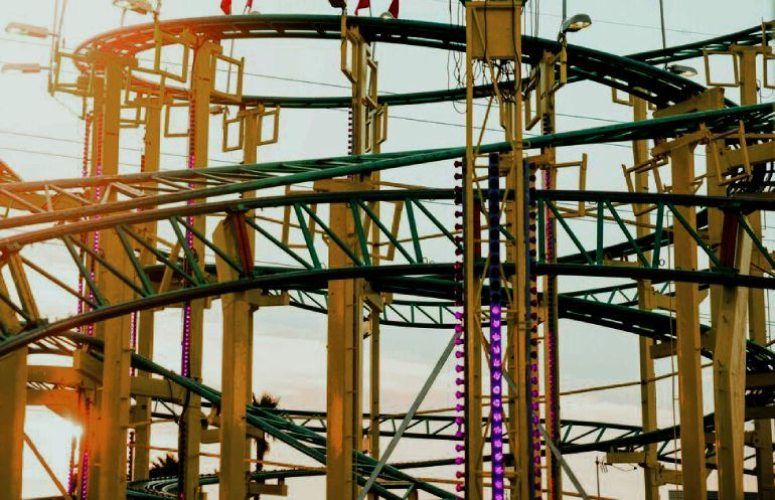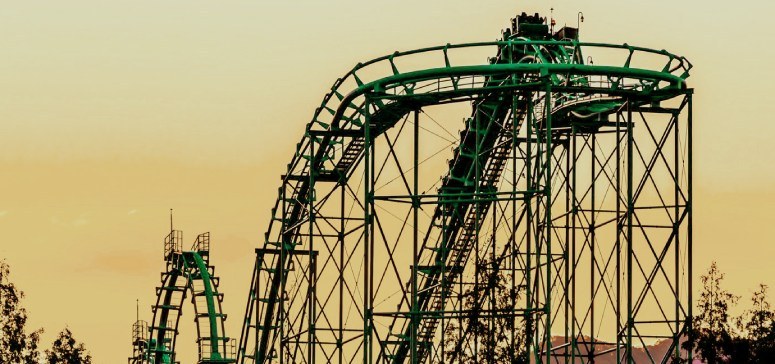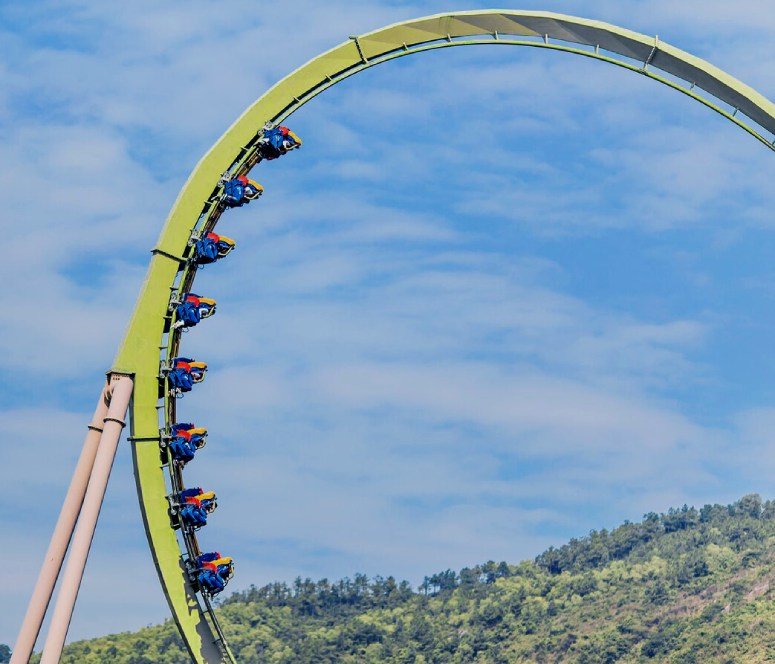Contents
- 1 Key takeaways
- 2 What are roller coasters?
- 3 How safe are roller coasters?
- 4 What are the odds of dying on a roller coaster?
- 5 What are the possible injuries from riding a roller coaster?
- 6 How to stay safe while riding a roller coaster?
- 7 Are there any age or health restrictions for riding a roller coaster?
Roller coasters are thrilling attractions that draw millions of adrenaline-seekers each year, offering an exhilarating escape from the ordinary.
But how safe are these rides really? This article explores the safety measures in place, and shows what are the odds of dying on a roller coaster
It also discusses potential injuries, necessary precautions, and age or health restrictions for riders.
Join the team of WhatAreTheOddsOf.NET to uncover the facts and help you ride with confidence!
Key takeaways
- Roller coasters are thrilling amusement park rides that have safety measures in place to prevent accidents;
- The odds of dying on a roller coaster are very low, with an estimated 1 in 750 million chance of a fatality;
- The most common causes of roller coaster accidents are mechanical failures, operator error, and rider behavior.
What are roller coasters?
Roller coasters are thrilling amusement park attractions that utilize gravity and mechanical design to deliver exhilarating experiences to riders, combining elements of speed, height, and intricate track layouts to create heart-pounding adventures.
These attractions come in various designs, from classic wooden coasters to modern steel constructions, each offering unique twists, drops, and heart-stopping turns that leave riders screaming for more.
The engineering behind roller coasters involves collaboration between manufacturers and designers, who must adhere to strict safety regulations and standards to ensure the safety and enjoyment of all riders.
How safe are roller coasters?
Regarding amusement park attractions, the safety of roller coasters is a paramount concern for both manufacturers and operators, as these thrilling rides can pose inherent risks to riders.
Despite the excitement and adrenaline rush that roller coasters provide, rigorous safety protocols and regulations are in place to minimize accidents and injuries, ensuring that the rides operate within established safety standards.
Reports and statistics from organizations like IAAPA showcase that injuries from roller coasters are relatively rare when compared to the number of rides taken each year, highlighting the importance of continuous safety improvements and inspections.
What are the safety measures taken for roller coasters?
Safety measures for roller coasters involve a comprehensive approach that includes regular inspections, maintenance protocols, and safety training for operators to minimize the risks associated with these thrilling rides.
The industry adheres to strict guidelines established by organizations like IAAPA, ensuring that amusement parks maintain high safety standards for all attractions.
These measures encompass everything from mechanical checks of equipment to ensuring proper seating and harnessing for riders, all aimed at creating a secure environment for the adrenaline-fueled excitement that roller coasters provide.
To enhance safety, operators typically implement a variety of protocols that encompass both mechanical and human error factors.
- Regular equipment checks are essential in identifying any wear or malfunction, which could pose risks if left unaddressed;
- Training programs for staff ensure they are well-equipped to manage emergencies and understand operational procedures thoroughly;
- Emergency protocols are established, including systematic evacuation procedures and immediate response plans for incidents.
The importance of human factors cannot be overstated – detailed procedures are in place to ensure operators follow standardized protocols while addressing any unusual rider behavior or operational anomalies.
Such comprehensive measures work collaboratively to build a safety net around both the thrill-seekers and the operators, contributing to a safer amusement experience.
What are the odds of dying on a roller coaster?
The odds of dying on a roller coaster are remarkably low, with statistics showing that the chances of a fatal incident occurring on these thrilling rides are significantly less than many other forms of entertainment or transportation.
According to safety reports, the rigorous safety standards and protocols enforced by amusement parks and industry organizations have effectively minimized the risks associated with roller coasters, making them one of the safest amusement park attractions.
While the thought of accidents can create apprehension among riders, understanding these statistics can help alleviate fears and emphasize the careful measures taken to ensure a thrilling yet safe experience.
What are the most common causes of roller coaster accidents?
The most common causes of roller coaster accidents can often be attributed to mechanical failures and human error, both of which pose significant risks when safety protocols are not strictly followed.
While roller coasters are designed with multiple redundancies to prevent failures, instances of poor maintenance, faulty equipment, or operator misjudgment can lead to serious incidents.
Understanding these causes is crucial for manufacturers and park operators to enhance safety measures and develop guidelines that mitigate these risks effectively, ensuring that roller coasters remain enjoyable and safe attractions.
According to recent statistics, mechanical failures account for approximately 30% of roller coaster accidents, while human error is responsible for about 25%. Such breakdowns can stem from inadequate inspections or wear and tear of crucial components.
For instance, a lack of proper lubrication in moving parts can result in unexpected malfunctions.
- Historical data shows that about 15% of incidents occurred due to operational mistakes made by ride operators;
- In many cases, the absence of comprehensive training programs for staff has been highlighted.
In response to these alarming figures, parks have implemented strict safety protocols, including routine maintenance checks and enhanced training for operators. One notable incident in recent years involved a roller coaster that derailed due to a mechanical failure from worn-out tracks.
Following that incident, new policies were enacted to increase the frequency of inspections, showcasing the industry’s commitment to safety improvements.
What are the most dangerous roller coasters in the world?
Some of the most dangerous roller coasters in the world have garnered attention due to their history of incidents and the statistics surrounding rider safety, prompting discussions about ride design and safety protocols.
Attractions like “The Smilar” at Alton Towers have faced scrutiny following accidents, leading to heightened awareness and discussions among safety experts and amusement park operators.
While these coasters offer unparalleled thrills and adrenaline-pumping experiences, their reputations highlight the importance of stringent safety measures, continuous monitoring, and adherence to regulations to protect riders.
For instance, “The Smilar” has been involved in multiple incidents, including a serious crash in 2015 that resulted in injuries to 16 riders.
This event sparked a comprehensive safety review, initiated by both the park and industry regulators. In response, extensive modifications were made, including:
- Upgraded safety protocols during maintenance checks;
- Improved emergency response training for staff;
- Regular inspections conducted by independent agencies.
Statistics reveal that despite the inherent risks associated with thrilling rides, the overall accident rates in amusement parks have declined significantly due to increased awareness and proactive safety measures.
Efforts like these are not only essential for maintaining trust among thrill-seekers but also for enhancing the overall experience without compromising safety.
What are the possible injuries from riding a roller coaster?
Riding roller coasters can lead to various possible injuries, although they are typically rare and often mild, such as whiplash or minor bruises, attributed to the intense forces experienced during the thrill of the ride.
More severe injuries can occur in rare cases, often as a result of improper seating or non-compliance with safety protocols.
Statistics show that while injuries do happen, they are generally low in frequency compared to the millions of rides taken annually, reinforcing the importance of adhering to safety guidelines designed to protect riders.
What are the most common injuries from roller coasters?
The most common injuries reported from roller coaster rides typically include minor ailments such as headaches, neck strain, and bruising, which are generally due to the intense physical forces experienced during the ride.
These injuries, while uncomfortable, are often avoidable by adhering to safety protocols and following the ride’s instructions regarding seating and harnessing.
Statistics indicate that serious injuries are rare, highlighting the effectiveness of safety standards in minimizing the risk of harm while allowing riders to experience the excitement roller coasters have to offer.
Plus the aforementioned injuries, roller coaster accidents can sometimes lead to more concerning conditions, including dislocations and concussions, but these are considerably less frequent.
The majority of reported injuries stem from the unexpected accelerative forces that riders encounter, particularly during sharp turns and sudden drops.
Understanding the exact nature of these risks involves examining statistical data – for instance, while millions enjoy roller coasters annually, studies suggest that only a tiny fraction, approximately 1 in 16 million rides, results in a significant injury.
- Headaches – Result from the sudden jerks and jarring movements;
- Neck Strain – Often caused by rapid forces acting on the neck during high-speed turns;
- Bruising – Can occur from the body being pressed against the harness during intense moments.
To enhance rider safety, amusement parks implement rigorous safety measures and conduct regular equipment inspections, effectively preventing serious accidents.
The combination of adhering to established safety guidelines and utilizing modern engineering is essential in ensuring a thrilling yet safe roller coaster experience for all.
What are the most severe injuries from roller coasters?
Severe injuries resulting from roller coaster accidents, while rare, can include traumatic brain injuries, fractures, and spinal injuries, often resulting from mechanical failures or non-compliance with safety protocols.
Instances of serious injuries can evoke public concern and lead to calls for stricter safety regulations and oversight in the amusement park industry.
Understanding these severe injuries highlights the need for continuous improvements in safety measures and thorough inspections to protect riders during their thrilling experiences.
For example, in 2016, a lethal incident at a popular amusement park raised alarms when a malfunction on a roller coaster led to a rider suffering catastrophic spinal injuries.
Reports revealed that mechanical inspections had not been adequately conducted prior to the reopening of the ride which had undergone repairs. Similarly, several ride-related injuries over the past decade have sparked various investigations.
- In a 2014 case, a young rider experienced a traumatic brain injury due to a lack of safety harnesses;
- Another incident in 2019 involved a rider who suffered multiple fractures after falling from an unsecured seat.
These instances underscore the critical importance of adhering to established safety protocols, as even minor oversights can result in significant harm. Therefore, ensuring rigorous inspections and safety measures is paramount in preventing these devastating consequences.
How to stay safe while riding a roller coaster?
Staying safe while riding a roller coaster involves adhering to specific precautions and safety protocols designed to minimize risks and ensure a thrilling yet secure experience for all riders.
By following the instructions provided by operators, ensuring that all safety restraints are properly engaged, and being aware of personal health and comfort levels, riders can significantly reduce the likelihood of injuries during their adrenaline-pumping adventures.
Understanding these precautions can help riders fully enjoy the excitement of roller coasters while prioritizing their safety and well-being.
What are the precautions to take before riding a roller coaster?
Before riding a roller coaster, it is crucial to take certain precautions to ensure both safety and enjoyment, including understanding and following the safety instructions provided by park operators.
Riders must be aware of their surroundings and any specific guidelines that may pertain to the ride they are about to experience.
It is recommended that individuals perform a health assessment before embarking on such thrilling experiences. This involves considering any recent surgeries, medical conditions, or medications that could impact their physical response.
Securing belongings like hats and glasses is important to prevent them from becoming hazards during the ride. Here are some essential precautions riders should take:
- Ensure all safety restraints are tightly fastened;
- Pay attention to any special instructions given by ride operators;
- Stay hydrated and take breaks if feeling anxious or overwhelmed.
These proactive steps not only enhance the safety of the ride but also contribute to a more enjoyable experience overall.
What to do if you feel unsafe during a roller coaster ride?
If you feel unsafe during a roller coaster ride, it is vital to remain calm and follow the safety protocols implemented by the amusement park, which are designed to address emergencies and ensure rider safety.
Effective communication with the ride operators is paramount in these situations. They have specific training to handle emergencies and can take swift actions to assist riders. If you find yourself feeling uneasy, try to signal to the nearest operator, or verbalize your discomfort loudly enough for them to hear.
This ensures that someone is aware of your situation and can oversee the ride’s conditions.
- Keep your hands inside the vehicle at all times;
- Stay seated until the ride comes to a complete stop;
- Remain aware of your surroundings and listen to any announcements made by the operators.
Most amusement parks have emergency protocols in place that include immediate stops, safety checks, and assistance from qualified personnel. Familiarizing yourself with these procedures can greatly contribute to feeling secure while enjoying the ride.
Are there any age or health restrictions for riding a roller coaster?
Age and health restrictions for riding roller coasters are commonly implemented by amusement parks to ensure the safety and well-being of all riders, particularly for those with certain medical conditions or those who are too young to safely experience the ride’s intense forces.
These guidelines are established based on safety protocols that consider the physical demands that roller coasters place on riders, aiming to minimize the risks of injury while allowing thrill-seekers to enjoy the adventures safely.
Understanding these restrictions helps in making informed decisions about which rides are suitable for individuals based on their health and age.
What are the age restrictions for riding a roller coaster?
Age restrictions for riding roller coasters vary by amusement park and specific ride, with most parks implementing guidelines that generally prohibit young children from riding due to safety concerns and the physical demands of the attraction.
These restrictions are crucial in ensuring the safety of all guests, as the extreme speeds and sudden changes in motion can pose significant risks if proper precautions are not observed.
Typically, parks set specific height and age criteria for each attraction. For instance, a popular thrill ride may require riders to be at least 54 inches tall or 10 years old, while family-oriented attractions might allow younger children as long as they meet a minimum height requirement.
- The “Goliath” coaster, for example, has an age restriction that emphasizes the need for riders to be both tall and mature enough to handle its twists and turns;
- On the other hand, a gentler ride, like a carousel, may have no age limit, allowing even the youngest visitors to participate.
By adhering to these age restrictions, families can help ensure their children experience the excitement of the rides without compromising their safety, fostering a fun day out that prioritizes well-being.
What are the health restrictions for riding a roller coaster?
Health restrictions for riding roller coasters are put in place to protect individuals who may have certain medical conditions that could be exacerbated by the intense physical forces experienced during the ride.
These guidelines are designed to maintain rider safety and prevent serious health issues. Riders should be aware that specific health conditions can significantly impact their ability to safely enjoy roller coasters. For example:
- Heart conditions – Individuals with a history of heart disease may experience elevated heart rates or increased blood pressure, making roller coaster rides potentially dangerous;
- Neck or back problems – Those suffering from chronic pain or injuries in these areas may find that the sudden jerks and motions can cause discomfort or further injury;
- Pregnancy – This condition brings unique physiological changes that can complicate safety on rides, mainly due to the stress and forces experienced during the ride.
Understanding these health guidelines is crucial for riders to ensure their safety and the well-being of others while enjoying roller coasters. Respecting these restrictions not only fosters a safer environment but also enhances the overall experience for everyone.
Our FAQ section, located a bit lower on the page, addresses the odds of dying on a roller coaster.



